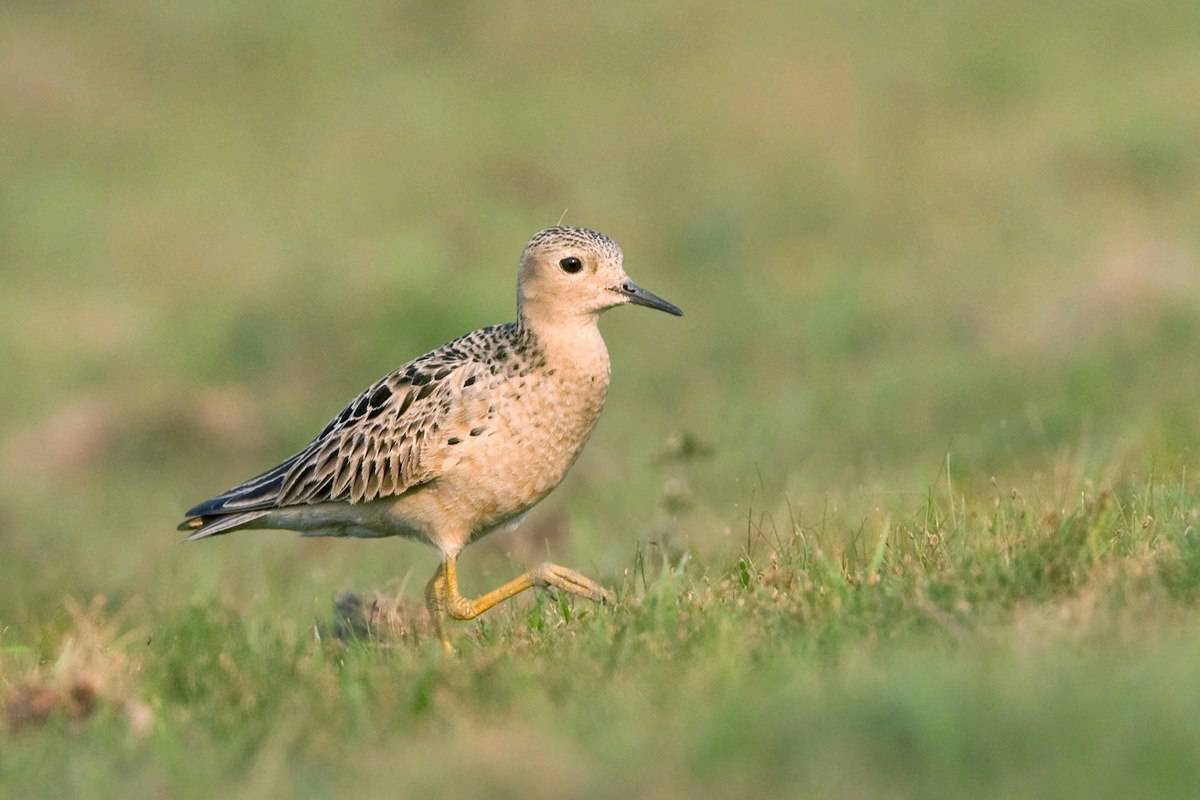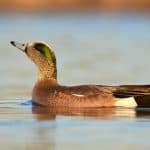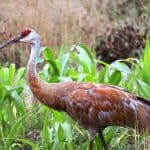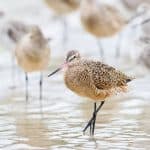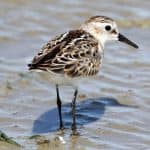Common Name: Buff-breasted Sandpiper
Scientific Name: (Calidris subruficollis)| Size | Diet | Range in Hawaii | Status in Hawaii |
|---|---|---|---|
| 8 in. - 9 in. | insects and small invertebrates | Kaua'i, O'ahu, and Big Island | Near Threatened |
The Buff-breasted Sandpiper, also known as Calidris subruficollis, is a small shorebird species that is native to the grasslands of North America. While the species is not native to Hawaii, it has been known to occasionally visit the islands as a non-breeding visitor and vagrant. With its unique appearance and distinctive behavior, the Buff-breasted Sandpiper is a fascinating bird species that has captured the attention of birdwatchers and avian enthusiasts around the world.
In this article, we will explore the world of the Buff-breasted Sandpiper, its unique characteristics, and its occasional presence in Hawaii.
Buff-breasted Sandpiper
Appearance
The Buff-breasted Sandpiper is a striking shorebird known for its distinct appearance. It stands out with a relatively small size, measuring around 8 to 9 inches (20 to 23 centimeters) in length. This bird is characterized by its soft, buff-colored plumage that covers its entire body.
Its head and neck are notably lighter in color, and its overall appearance exudes a subtle elegance. During the breeding season, males develop a bold black patch on their chest that adds a touch of contrast to their otherwise delicate appearance.
Diet

This dainty shorebird primarily feasts on a variety of insects and their larvae, making it an adept insect hunter. During its breeding season in the Arctic tundra, it forages for insects such as flies, mosquitoes, and other small invertebrates in the lush vegetation of its breeding grounds.
As a migratory bird, the Buff-breasted Sandpiper’s diet may shift slightly during its travels. In its non-breeding range in South America, it might include small crustaceans and seeds in its diet.
Nesting
When it’s time to breed, Buff-breasted Sandpipers select open, mossy tundra habitats near shallow ponds or wetlands in the Arctic regions of North America. Unlike many other birds that construct intricate nests, Buff-breasted Sandpipers opt for a simpler approach. They create small, shallow scrapes in the ground, lined with a sparse amount of plant material, typically moss or lichen.
These minimalist nests blend seamlessly with the tundra’s natural landscape, providing camouflage and protection for their precious eggs. Buff-breasted Sandpipers lay a clutch of eggs, usually consisting of four eggs, which are creamy to pale green in color, helping them blend in with the surrounding environment.
Behavior
During the breeding season, males establish and defend territories with courtship displays and aerial acrobatics. Their nesting behavior is minimalist, with shallow scrapes in the ground lined with moss or lichen, blending seamlessly with the landscape.
These birds are remarkable long-distance migrants, journeying from their Arctic breeding grounds to South American wintering areas. Solitary in nature, they occasionally take short naps during the day to conserve energy.
Their cryptic plumage helps them blend into their habitat, and males engage in nocturnal singing to establish territories and attract mates. The Buff-breasted Sandpiper’s behavior reflects its adaptability and endurance in the challenging environments it inhabits.
Habitat
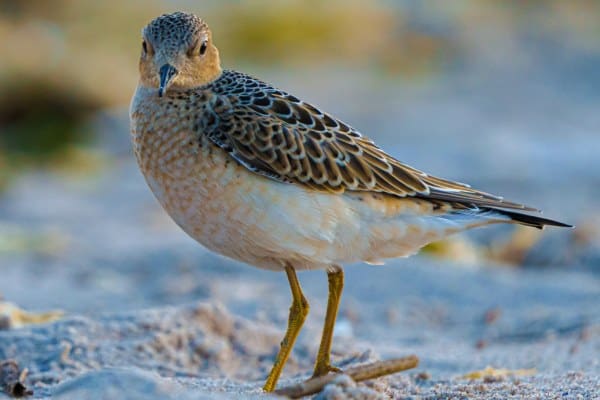
What truly sets them apart is their graceful courtship ritual. When attempting to woo a mate, these sandpipers engage in an intricate dance, gracefully fluttering their wings and hopping in a rhythmic display of elegance. This enchanting courtship dance is a sight to behold and a testament to the bird’s exquisite courtship rituals.
Another intriguing aspect of the Buff-breasted Sandpiper’s behavior is its gentle foraging style. Unlike their shorebird cousins that probe the mud and sand for food, Buff-breasted Sandpipers delicately pick insects and other invertebrates from the grassy plains, almost like a dainty ballet of feeding.
Moreover, these birds are known for their nomadic tendencies during migration, covering vast distances and displaying an incredible sense of navigation as they traverse continents in search of suitable habitats. The Buff-breasted Sandpiper’s behavior is a testament to the diversity and wonder of the avian world, reminding us that even within a single family of birds, there can be remarkable variations in behavior and lifestyle.
Range
The Buff-breasted Sandpiper, typically a non-breeding visitor, is a rare sight in Hawaii. This elegant shorebird, which breeds in northern Alaska and Canada and winters in South America, occasionally makes its way to the Hawaiian Islands as a vagrant during the fall months. In the southeastern Hawaiian Islands, sightings have occurred on Kaua’i, O’ahu, and Hawai’i Island, with descriptions indicating that these were first-fall individuals.
Conservation Status
The Buff-breasted Sandpiper is classified as “Near Threatened” on the International Union for Conservation of Nature (IUCN) Red List. The primary reasons for its vulnerable status include habitat loss and degradation. These birds depend on expansive grasslands for breeding, but these habitats are increasingly threatened by agricultural expansion, urban development, and climate change-induced alterations in vegetation patterns.
Interesting Facts
1. Social nesting
Buff-breasted Sandpipers often nest in loose colonies, with several pairs nesting relatively close to each other. This social nesting behavior can provide some protection against predators.
2. Noisy feeders
When foraging, these sandpipers emit soft calls and chirps. Their vocalizations are relatively quiet compared to other shorebirds, reflecting their gentle and unobtrusive feeding habits.
3. Important indicators
Buff-breasted Sandpipers are considered indicator species for the health of grassland ecosystems. Their presence or absence can signal changes in these environments, making them valuable subjects for ecological research and conservation efforts.
4. Cultural significance
In some indigenous cultures, the arrival of Buff-breasted Sandpipers during their migration is seen as a seasonal indicator, signaling the changing of the seasons and influencing traditional practices.
5. Distinctive bill shape
Buff-breasted Sandpipers have a relatively short and straight bill, which is adapted for their ground-based foraging in grasslands. This sets them apart from other sandpipers with longer, curved bills suited for probing in mud or sand.
Frequently Asked Questions
1. What other bird species are often associated with Buff-breasted Sandpipers during their migrations?
They can be seen with other shorebirds like Pectoral Sandpipers, Semipalmated Sandpipers, and American Golden-Plovers during migration, as they often share similar habitats and migration routes.
2. How do Buff-breasted Sandpipers differ from other sandpipers?
Buff-breasted Sandpipers are distinguishable by their buff-colored plumage during the breeding season and their preference for grasslands over wetlands. They also have a straight bill, unlike the curved bills of many other sandpipers.
3. Do Buff-breasted Sandpipers travel in flocks during migration?
Yes, these sandpipers often migrate in flocks, sometimes joining mixed-species groups with other shorebirds. Their synchronized flights can be quite impressive.
4. What is the best time to observe Buff-breasted Sandpipers during their migration?
The best time to observe Buff-breasted Sandpipers during their migration is during their stopover periods, which occur in late summer and early fall as they travel to their wintering grounds in South America.
5. What is the lifespan of a Buff-breasted Sandpiper?
Buff-breasted Sandpipers can live for several years, with the oldest known individual reaching nearly 11 years of age.
